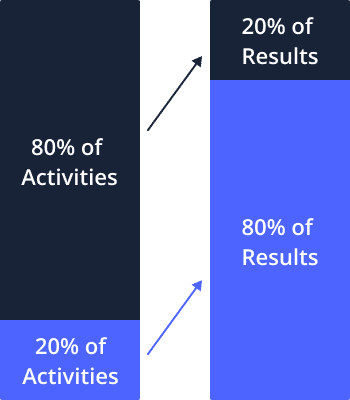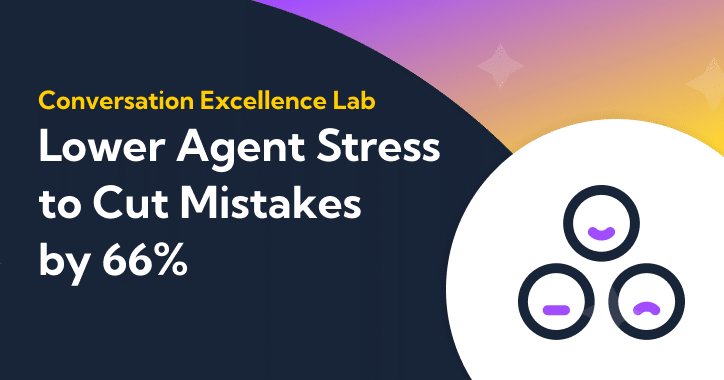When it comes to outlasting a global recession, sometimes it’s less about how you save money and more about how you spend it. The Pareto Principle states that 80% of outputs are caused by 20% of inputs — this thought process can be applied to budgeting as well. What are the core processes that provide the most upside to your company, and where can corners be cut?

Figure 1: The Pareto Principle
Shifting budgets to stay competitive is a natural — if not essential — survival tactic during difficult financial times, but be wary of cutting into the business functions, like your contact center, that have an outsized impact on your customers.
The Conversation Excellence Lab surveyed over 360 contact center executives about their budgeting plans. We learned:
- Industries that are planning on cutting their contact center budgets in the next year have higher churn rates than those who aren’t. The higher the cut, the higher the churn rate.
- Meanwhile, industries that are not planning on cutting costs do the best in terms of churn, NPS, and CSAT.
- Value perception may have a greater impact than actual spending when it comes to improved churn and customer satisfaction.
Subscribe to future Conversation Excellence Lab reports below:
Demographics
We surveyed 361 executives across the United States. For the purpose of this survey, we defined executives as Directors, Vice Presidents, Presidents, and C-Suite Executives.
We asked respondents to identify their industries across 20 choices: BPO (Business Process Outsourcing), Real Estate, Home Improvement, Logistics, Government & Non-Profit, Education, Transportation, Travel & Hospitality, Professional Services, Collections, Financial Services, Technology, Healthcare, Retail, Construction, Manufacturing, Insurance, Utilities, Telecommunications & IT, or Other.
Our biggest percentage of respondents, 13.3%, fell into the Financial Services category. Our smallest represented industry was BPO, 0.28%. All data has been weighted for accuracy.
Figure 2: Industry investment in contact center coaching and technology in the next year
The industries which were planning to spend the most on contact center coaching and technology in the next year were Transportation ($3,860,000 in total), Technology ($3,400,252), Financial Services ($2,318,812), Retail ($2,132,184), and Telecommunications ($2,035,069). The industries that planned to invest the least were Other ($200,000), Government & Non-Profit ($417,647), and Education ($487,500). How does your company stack up?
For a full breakdown of our demographic data, check out our full report here.
The Biggest Budget Cuts Come With the Highest Churn Rates
Executives who are planning to cut their contact center budgets in the next 12 months had higher churn rates than those who aren’t. This trend extends across every industry. The effect scales with the percentage by which the industry is planning to cut costs.
Only four industries — BPO, Real Estate, Home Improvement, and Logistics — had zero respondents with plans to cut their contact center budget in the coming year. These four industries reported an average agent churn rate of 19.12%.
In comparison, the industries with the highest reported cost cuts had the highest churn. These industries were Telecommunications and IT (53.63% are cutting costs), Utilities (50%), Insurance (42.86%), and Manufacturing (39.47%). The churn for these four industries was 38.63% on average, a little over double the reported churn rate of industries who were not cutting costs.
Figure 3: Effect of cutting costs on industry churn rates
While not as drastic as churn rates, NPS and CSAT scores also trended slightly lower the more an industry reported plans to cut costs. Those who said they were cutting costs had an average NPS score 4 points lower than those who said they weren’t, and their CSAT was approximately 9 points lower as well.
It’s important to note that these percentages don’t indicate how much each industry is planning to cut from the budget, only the percentage of respondents in each industry who are planning to cut any amount. Additionally, cost-cutting isn’t synonymous with cutting budgets across the board. Marketing budgets are often the first to go during downturns, while investments in technology may increase to stay competitive.
However, our data illustrates an uncomfortable truth: any amount of budget cut in the contact center is indicative of reduced customer satisfaction and a potential (and expensive) loss of personnel.
Industries Without Cuts Are Doing the Best
On the flipside, the industries that are not planning on cutting costs in the next year are doing the best in terms of churn, NPS, and CSAT. Interestingly, these responses came from companies who were spending less on average than the companies who were cutting costs, which suggests that the impact of spending on output is not a one-to-one relationship.
For example, the lowest churn on average belonged to companies that were investing up to $100,000 a year each on coaching and software. The highest churn belonged to those who spent between above $5,000,000 apiece on coaching and technology.
Figure 4: Effect of increased coaching investment on industry agent churn rate
Essentially, a company may invest millions in software and coaching and still see no improvements if those investments aren’t backed by a deep understanding of a contact center’s needs, pain points, and jobs to be done.
When a company is smaller, it’s more operationally straightforward to be close to a contact center’s workflow, and more intuitive to understand its problems. As a company scales and grows, leaders who are making budgeting decisions are often farther away from day-to-day workflows and may have an impaired understanding of what exactly to invest in and how to best implement those investments.
It’s not quantity, it’s quality.
There’s a vicious cycle present here: if a company does not understand its contact center operations, investments will be misdirected and mismanaged. They won’t lead to results and funds will be cut, leading to a perception of the contact center as a drain on resources when it is actually a center of value-creation.
When planning out your budget during a recession, think wisely not just about how much to spend, but about where and how to spend it. Overall, the industries who were not cutting costs had the best churn and customer satisfaction outcomes, but they were not spending more on average, and this distinction is important to internalize.
It’s All About Perception…
Value perception, that is. Think back to the Pareto Principle: 20% of inputs account for 80% of outputs. But not all inputs are created equally. As discussed in the previous section, the more that companies spend as a whole — not to be confused with whether they are increasing or decreasing their spending — the worse they perform on average in terms of churn and customer satisfaction.
How can this be explained? It’s not the influx of money that causes the churn directly, but it is possible that the more resources a company has, the more likely they are to mismanage or misallocate funds. Companies with smaller budgets, on the other hand, feel more pressure to spend that money well. In turn, they get more bang for their buck when it comes to improving the agent and customer experience.
Value is also a self-fulfilling prophecy. We asked respondents if they believed that their contact center was a drain on resources, and those that completely disagreed had an average churn of 16.9%, NPS of 80.4, and CSAT of 86.3 compared to 48%, 73.5, and 79.1, respectively for those that completely agreed.
Companies who spent more than $500,000 on coaching and technology for their contact center had worse outcomes when it came to churn and customer success, but they were also the most likely to agree with the following statements:
- Excellent service is less important than solving a customer’s problem as quickly as possible.
- Anything other than self-service support for customers ends up being a drain on company resources.
Figure 5: Opinion of contact center value in relation to planned contact center investments
Simply put, they may be investing the money, but they don’t see their contact center as valuable. If executives are more likely to see their contact center as a drain on resources, churn and customer satisfaction are going to suffer — no matter how much is spent on software or coaching.
This is not to say that investment in your contact center isn’t important — quite the opposite. The difference is intent: are you investing in your contact center to improve customer experiences and agent satisfaction, or to operate efficiently and reduce costs? Do you have your finger on the pulse of your contact center needs?
Conclusion
Your contact center is your front line. It is one of the primary ways that your customers interface with your product, and its performance can make or break your bottom line from a sales or customer churn perspective. Not investing in your contact center is akin to not investing in your company’s future. With a looming recession, this kind of investment becomes even more important.
Sources
Kumar, N. & Pauwels, K. (August 14, 2020) Don’t Cut Your Marketing Budget in a Recession. Harvard Business Review. Retrieved August 10, 2022, from https://hbr.org/2020/08/dont-cut-your-marketing-budget-in-a-recession
Qualtrics. (July 8, 2022) Despite looming recession, C-suite leaders are more confident about their own companies. Qualtrics. Retrieved August 10, 2022, from https://www.qualtrics.com/blog/recession-news/
Balto. (August 3, 2022) How to Recession-Proof Your Contact Center, According to 360+ Executives. Balto AI. RSS. Retrieved August 10, 2022, from https://www.balto.ai/research/how-to-recession-proof-your-contact-center/






